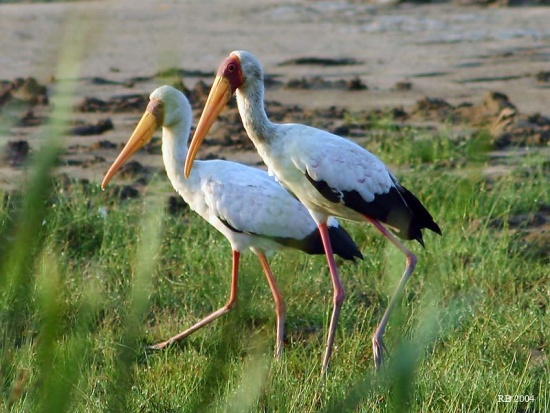(→Taxonomy: Update link) |
(Juvenile & Flight pictures. References updated) |
||
| Line 1: | Line 1: | ||
| − | [[Image:Yellow-billed_Stork.jpg|thumb|550px|right|Photo by {{user|rudydbn|rudydbn}}]] | + | [[Image:Yellow-billed_Stork.jpg|thumb|550px|right|Photo by {{user|rudydbn|rudydbn}}<br />St Lucia, Natal, [[South Africa]]., October 2004]] |
;[[:Category:Mycteria|Mycteria]] ibis | ;[[:Category:Mycteria|Mycteria]] ibis | ||
==Identification== | ==Identification== | ||
| Line 12: | Line 12: | ||
*Black tail and wing quills | *Black tail and wing quills | ||
*Long, pink or dark red legs | *Long, pink or dark red legs | ||
| + | [[Image:IMG 46332.JPG|thumb|350px|right|Juvenile<br />Photo by {{user|Abubakr+Mohammad|Abubakr Mohammad}}<br />Sudan, April 2011]] | ||
==Distribution== | ==Distribution== | ||
Found in [[Africa]] (south of the Sahara) including [[Madagascar]]. | Found in [[Africa]] (south of the Sahara) including [[Madagascar]]. | ||
| Line 21: | Line 22: | ||
==Behaviour== | ==Behaviour== | ||
====Diet==== | ====Diet==== | ||
| + | [[Image:Yellow-Billed Stork4.JPG|thumb|350px|right|Photo by {{user|Expiry|Expiry}}<br />Lake Navasha, [[Kenya]], November 2009]] | ||
The diet includes crustaceans, small fish, frogs, insects and worms. | The diet includes crustaceans, small fish, frogs, insects and worms. | ||
====Breeding==== | ====Breeding==== | ||
Both sexes build the bulky stick nest. The 2-3 eggs are laid on alternate days and are incubated for 30 days. | Both sexes build the bulky stick nest. The 2-3 eggs are laid on alternate days and are incubated for 30 days. | ||
==References== | ==References== | ||
| − | #{{Ref- | + | #{{Ref-Clements6thAug14}}#WhoZoo |
{{ref}} | {{ref}} | ||
==External Links== | ==External Links== | ||
Revision as of 22:52, 21 January 2015
- Mycteria ibis
Identification
97cm
- Orangey-red face
- Bill
- Long and thick
- Slightly curved
- Bright yellow
- Long, slender, greyish-white neck
- White back, belly and breast, lightly tinged with pink on feather tips
- Black tail and wing quills
- Long, pink or dark red legs
Distribution
Found in Africa (south of the Sahara) including Madagascar.
Taxonomy
This is a monotypic species[1].
Habitat
Shallow lakes, mud flats, coastal lagoons and meadows.
Behaviour
Diet
The diet includes crustaceans, small fish, frogs, insects and worms.
Breeding
Both sexes build the bulky stick nest. The 2-3 eggs are laid on alternate days and are incubated for 30 days.
References
- Clements, J. F., T. S. Schulenberg, M. J. Iliff, D. Roberson, T. A. Fredericks, B. L. Sullivan, and C. L. Wood. 2014. The eBird/Clements checklist of birds of the world: Version 6.9., with updates to August 2014. Downloaded from http://www.birds.cornell.edu/clementschecklist/download/
- WhoZoo
Recommended Citation
- BirdForum Opus contributors. (2024) Yellow-billed Stork. In: BirdForum, the forum for wild birds and birding. Retrieved 21 May 2024 from https://www.birdforum.net/opus/Yellow-billed_Stork
External Links






